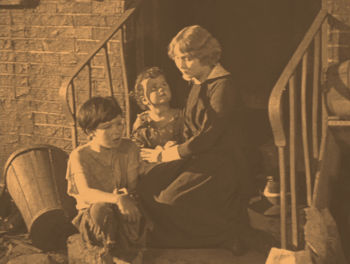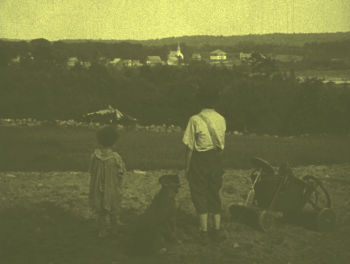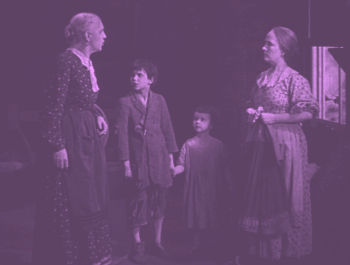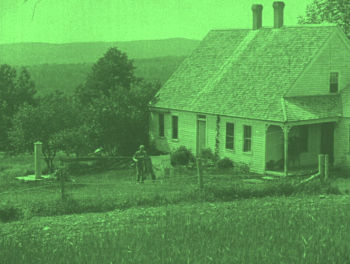Timothy’s Quest (Dirigo, 1922)
 Timothy’s Quest (Dirigo, 1922)
Timothy’s Quest (Dirigo, 1922)
Directed by Sidney Olcott
Starring Joseph Depew and Helen Roland
10 year old Timothy (Joseph Depew) and his 4 year old sister Gay (Helen Roland) are orphans. They’re fundamentally good kids, but the slum they live in is in a rough and violent part of the city (Boston? New York? It doesn’t really matter — it’s the city). Their only ray of hope comes from Miss Dora, the “Angel of the Alley” (Gladys Leslie). She’s a social worker or something of that nature. Timothy’s entire world is confined to this slum and he knows nothing else. Dora suggests he make a “picture prayer”, which she describes as thinking about a wish long enough that the wish comes true. I think Oprah called it “The Secret”. Anyway, Timothy’s picture prayer is of a white house in the country where there lives a kindly lady who wants to adopt them.
The occasional money the kids received from some anonymous source has dried up and the two drunks who keep them have decided to give Gay to the Ladies’ Relief Home and send Timothy to the state orphanage. With no desire to be split up, Timothy, Gay, and their dog (Rags) slip away under cover of darkness and hop a north-bound freight train — trusting in the picture prayer to see them through.
 The morning finds them overlooking a small cluster of houses built around a church nestled in the rolling hills of rural Maine. They continue on foot until they reach the envisioned house, although its owner is rather older than Timothy imagined, and of the several appellations that might be given her, “kindly” isn’t one of them. Avilda Cummins (Marie Day) dislikes the children from the start and wouldn’t have suffered them to stay a moment were it not for Samantha’s (Margaret Seddon) intervention. Samantha at some point in the distant past might have been termed a maid, but now “companion” is more fitting.
The morning finds them overlooking a small cluster of houses built around a church nestled in the rolling hills of rural Maine. They continue on foot until they reach the envisioned house, although its owner is rather older than Timothy imagined, and of the several appellations that might be given her, “kindly” isn’t one of them. Avilda Cummins (Marie Day) dislikes the children from the start and wouldn’t have suffered them to stay a moment were it not for Samantha’s (Margaret Seddon) intervention. Samantha at some point in the distant past might have been termed a maid, but now “companion” is more fitting.
And so Timothy and Gay tentatively remain at White Farm. Everyone is enamored by them — everyone but Vilda. The boy reminds her “of something in the past”, she says, and she “can’t stand to have [him] about”. To cut to the chase, Timothy and Gay were her sister’s children. She had gotten “in trouble” and was run out of town. And Vilda is angry: angry at her sister Martha, angry at the “good orthodox Christians” who turned their backs when Martha needed them most, and angry at herself for not supporting her.
 Vilda at last relents and adopts Timothy and Gay, and in doing so, comes to terms with the past.
Vilda at last relents and adopts Timothy and Gay, and in doing so, comes to terms with the past.
I’m from Maine. I know I’ve mentioned that on my book blog, but I don’t think it’s ever come up on this one. There are several films set in Maine, some pretty well known, but rarely were they actually filmed here. Way Down East (1920) didn’t get any nearer than Connecticut. At least that’s New England — Shadows (1922) was shot entirely in California. Timothy’s Quest (1922), the only production ever released by Dirigo Films, aside from being set in Maine was filmed here too. It was shot in and around Hollis, which is in the southern part of the state, not terribly far from Portland. It’s doubly interesting since most Maine films (silent and sound) focus on the coastal fishing and shipping centers rather than inland farming communities like Hollis. In fact, I can’t actually think of another example beyond Timothy’s Quest. I have to say, more than anything else, that’s what attracted me to the film when I saw it on Amazon. Maine is old and slow to change — for much of the state, 1922 is recent enough to be yesterday — and I hoped to see something familiar. I was not disappointed. The first view of town Timothy catches is, for the world, what I see going up route 4 on my way home. There’s nothing fake about the Maine of this film — it all rings perfectly true.
 Aside from my delight at the setting, it’s all around a good film. There’s hardly a weak performance — Depew and Day turn in particularly strong work. You might notice that Vivia Ogden reprises her role from Way Down East as the town gossip. It’s a fun callback, and the character suits her well. If I had any complaints, it’s that the story may be stretched a little thin at seven reels. It wouldn’t lose anything were it tightened up a bit, notably in the back half.
Aside from my delight at the setting, it’s all around a good film. There’s hardly a weak performance — Depew and Day turn in particularly strong work. You might notice that Vivia Ogden reprises her role from Way Down East as the town gossip. It’s a fun callback, and the character suits her well. If I had any complaints, it’s that the story may be stretched a little thin at seven reels. It wouldn’t lose anything were it tightened up a bit, notably in the back half.
I watched the recent Flicker Alley BD-R, which looks great aside from the mistimed tinting (the color changes consistently about half a second before the scene changes) and the tints maybe being a bit too strong. Although I rather think I have a 16mm print in my collection. If I do, I’ve never examined it and I’m not sure if it’s complete. If I remember after writing this, I must check.
My rating: I like it.
Available from Flicker Alley
Edit: Hey, I remembered, and hey, I do. In need of a thorough cleaning, but otherwise in good shape.
Posted on December 3, 2016, in Like it, Reviews and tagged 1922, Dirigo, Helen Roland, Joseph Depew, Sidney Olcott. Bookmark the permalink. 1 Comment.
Howdy!
Just to add, a large portion of this film was shot in Bridgton, at the Farnsworth-Decker House, which is still standing. Other portions were shot in our neighboring/nearby towns of Harrison, Casco and the historic Songo Lock. Wonderful stuff!